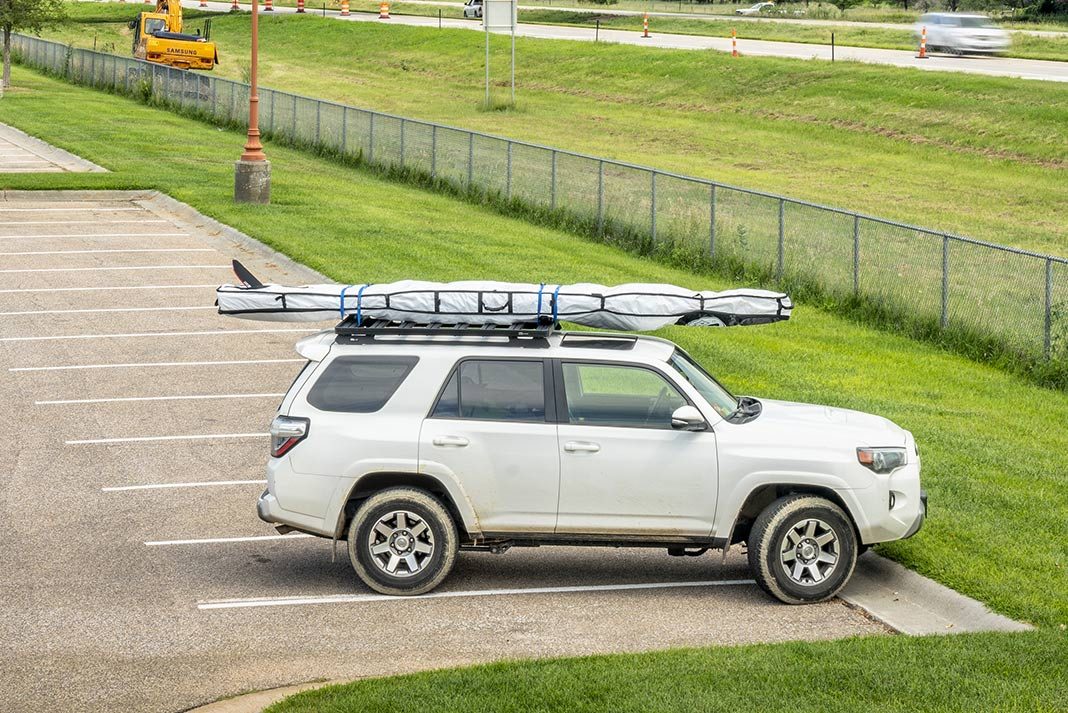There are few things as peaceful in life as standup paddling down a crystal-clear river that meanders through a quiet forest. But for many new paddleboarders, there are few things as stressful as figuring out how to get an expensive board onto the roof of a vehicle and then keeping it securely mounted as you speed down a highway.
Whether you’re coming from a canoe or kayak background—where loading the vessel onto the roof can be extremely challenging by yourself—or paddleboarding is how you’re introducing yourself to being on the water, transporting a board ranging from a short surf length to a 14-foot touring or racing board can be perplexing.
The good news is there’s a transportation method for every board and every vehicle. The parking lot of a paddling event is a lesson in vehicle diversity, with everything from two-door Smart cars to giant SUVs to event cargo vans converted into campers, where getting a board off the roof requires a tall ladder and a steady hand.
In this article, we’ll go over a few of the methods you can use to get your SUP to the put-in, as well as some helpful tips for keeping your board, vehicle and other vehicles on the road safe. Once you’ve reached the bottom of the page, you’ll know how to transport a paddleboard with ease and confidence.
The basics of loading and unloading
The great thing about paddleboarding is that, regardless of the length of board, nearly every model can be lifted onto a car without the help of a second person. There are some exceptions—such as heavier department store-type boards—but the vast majority of paddleboards can be loaded solo. Regardless of which roof rack setup (found below) your car might have, the loading process really starts before you take the board out of the garage or bring it back to your car from the beach.
There’s nothing worse than carrying your board to your car and then realizing you forgot to put the hatch down or left something on the roof. Before you bring your board to the car, make sure the roof racks are in place and the vehicle is clear and ready to have the board put on top. This will avoid you having to lay your board down in your driveway or trying to find a clear piece of grass for it.
The design of your board will determine which direction you point it and whether you lay it face-up or -down, although the basic shape of most boards means face-down is almost always best. Some people think having your board with the fin to the front is a good choice because if it starts to slide out, the fin will catch the straps and keep it from falling off the car. That said, unless you’ve incorrectly tied down the board, the odds of it sliding out are extremely slim. If I’m transporting a board with a particularly pointy nose, I’d rather have that up front to make it more streamlined than the boxy back end.
How to transport a paddleboard on a roof rack
In this section we’ll go over your first option for transporting a SUP: using a roof rack on your vehicle.
Understanding the parts of a roof rack
In order to figure out how you’re going to mount your board, it’s important to understand the terminology. There’s the roof itself, which is the easy one, but then there are: rails, which some cars have from the factory; crossbars, on which your board or a board rack will mount; mounting feet, which will allow crossbars to be mounted to vehicles without rails; and drip rails, which some cars have and allow for the feet to be mounted.
Think of it like this: the paddleboard sits on a board rack or crossbar cushions, which sit on the crossbars, which sit on the rail or which are mounted to feet which are attached to the car.
Simple, right?
Using the roof rack
With the popularity of crossovers and SUVs, many vehicles now come with built-in roof racks or at least rails, which are designed to mount factory or aftermarket crossbars.
Assuming your vehicle has crossbars, you have two options: you could either just mount the board directly onto the crossbars, or you could use a SUP-specific rack that mounts onto the crossbars and has straps built in. While they can save some time, those SUP racks can be a bit expensive, so most people simply use the crossbars.
If you do mount directly to the bars, it’s important to cover them with some sort of padding. This serves two purposes. First, it protects your paddleboard from getting damaged by the hard metal crossbars. Secondly, it allows your board to dig into the padding, making it less likely to move around while driving. Padding options range from hard foam to branded crossbar pads to something as simple as styrofoam pool noodles, which you can easily cut a slit in to slide them overtop of the bars.
Once your padding is in place, set the board on top in a way that doesn’t allow it to hang too far over the back of the vehicle. Depending on the length of the board, it may need to extend over your windshield and past the back bumper a little bit, but if it’s hanging off more than a couple of feet, it’s a good idea to hang a red or orange flag from the board. Many jurisdictions have laws in place that require these flags for any loads hanging more than 3 or 4 feet from the back of a vehicle.
The next step in mounting the board is tying it down. This is a step that should never be taken lightly as the tie-down straps are all that is keeping your board from becoming a very big and very dangerous flying object.
Rather than simply looping the strap around the rails and over the board (creating an oval of sorts), a much more secure way to mount it is to loop the strap around the rail first and then put both halves of the strap overtop of the board, closing the loop around the opposite rail. This will create an upside down C-shape of sorts, and means both halves of your strap are overtop of the board rather than one on top and one on the bottom.
If you don’t have rails and your bars are connected to the vehicle using mounting feet, simply loop the strap around the crossbar as close to the sides of board as you can get it.
Don’t fully tighten the front strap without first installing and snugging up the rear. The best way to provide even force on both straps is to snug them both up and then fully tighten them.
Can you put an inflatable SUP on a roof rack?
One of the most appealing things about inflatable paddleboards is the fact that they fold down to fit into a (large) backpack. That means loading a board into a vehicle takes about as long as throwing a bag into the truck or hatch of a car. Of course, the tradeoff is allowing 10 minutes of preparation time before and after your paddle to inflate and deflate the board.
The question that often comes up for people using their inflatable boards on a regular basis is whether or not they can be transported on the roof of a car while inflated. The good news is that quality inflatable standup paddleboards today are surprisingly rigid, which means even 12-foot, 6-inch or 14-foot boards can be transported without folding in half like a poorly tied-down mattress.
Keep in mind that you are still transporting an air-filled vessel, meaning something hitting it could result in a puncture. That being said, something hitting your inflatable with enough force to cause a hole would also cause significant damage to a hard board.
How to transport a paddleboard without a roof rack
Many sedans and hatchbacks don’t come with roof racks or rails. While aftermarket roof racks can be installed on just about any vehicle, complete systems can be expensive. But if your car has a smooth roof, don’t worry, you’re not out of luck.
Mounting a paddleboard to the roof of any car is fairly easy. One of the best options for this is a soft rack system from companies such as Sea to Summit. These are relatively inexpensive and have protective pads that sit on the roof and straps that run through the interior of the vehicle to keep the paddleboard in place.
Purpose-built foam blocks are also a good option because they typically have a grippy surface on one side to keep the foam from sliding on the roof of the car and a soft surface on the other for protecting your paddleboard. With the blocks in place and the paddleboard on top, wrap the straps around the board and through the door openings. Make sure to fully tighten the straps before closing the doors.
Keep in mind that the straps will be causing a small gap between the seal of the door and the door frame, so if you’re driving in rain, water will likely permeate the straps and drip into your interior.
How to transport a paddleboard in a truck
Trucks are great for transporting things that fit into the pickup bed, but with most paddleboards ranging from 10 to 14 feet, mounting them is a little more complicated.
Assuming the truck doesn’t have a rack system built in (in which case mounting the board is the same as with any vehicle with a rack), you’ll need to have the board hanging off the back. Close the tailgate and set the board as far into the pickup bed as it will reach. Put some sort of padding over the tailgate and then tie the board down as close to the tailgate as possible using the the tie-down mounts in the bed or on the side rails of the truck.
As mentioned above, if the board hangs past the tailgate by more than a couple of feet, a red or orange marker is highly recommended, and might be required by law.
How to transport two paddleboards
Unless you have extremely wide crossbars, carrying two boards will mean stacking them on top of each other to turn your vehicle into a double paddleboard rack. To do this, load the first board onto the bars as suggested above, typically with the fin at the back of the vehicle. Next, put some padding on top of the first board so the two paddleboards aren’t directly touching each other. Pool noodles or plumbing insulation works great for this because they don’t create much of a gap between the two boards. Offset the boards so the top board sits just in front of the fin of the bottom board.
Understanding how to tie down two paddleboards isn’t much different from one board. Just strap the two paddleboards to the vehicle as suggested above with the straps going all the way over the top of the two boards. Longer straps might be required.
If you have a particularly tall vehicle like an SUV, be cautious entering garages or parking structures. Know how tall the total setup is and pay attention to height restrictions.
Other considerations
To bag or not to bag
Other than inflatable boards, it’s extremely rare for paddleboards to be sold with a bag included. Depending on the length of board and the style of bag, these can cost as much as $300. But is it a worthwhile investment?
A major concern with transporting paddleboards on the roof of the car is the impact of a hot sun. While the vehicle is in motion, the board is being constantly cooled by the wind, but if you’re leaving your board on a car all day at the office in order to hit the water as soon as the work day is done, the hot sun can be damaging. High-quality paddleboard bags have thermal protection to keep the sun rays at bay. An added benefit is protecting your board from rocks and road debris that might fly up and hit it while driving.
Most bags are not water-tight, so expect there might be some water in the bag if you’re driving in a heavy rain. It’s recommended that you leave the zipper open slightly at the back to allow the water to drain out. Keeping the zippers at the back rather than the front is also important because the wind will push the zippers open if they’re at the front of the bag. Paddleboard bags also keep boards protected in garages and sheds, but it’s always a good idea to let the board and bag dry off before storing it away.
Locked and loaded
Another big concern with leaving paddleboards on the roof is how to secure them. Unlike canoes or kayaks, which have easy places to run cable locks through, the simplicity of paddleboards means there are few options for locking them on the roof. Locking tie-down straps aren’t inexpensive, but they’re a must anytime you’re leaving a board on the roof unattended. They have metal-reinforced straps and key-locks on the closure, which should be enough to deter thieves looking for a quick slash and grab.










I’d like to know the best way to transport both a kayak and a sup at the same time on a roof rack. Any suggestions? Ideally, I’d like to also be able to transport 2 kayaks and a sup. If the sup could go vertical next to one of the kayaks, it would work.